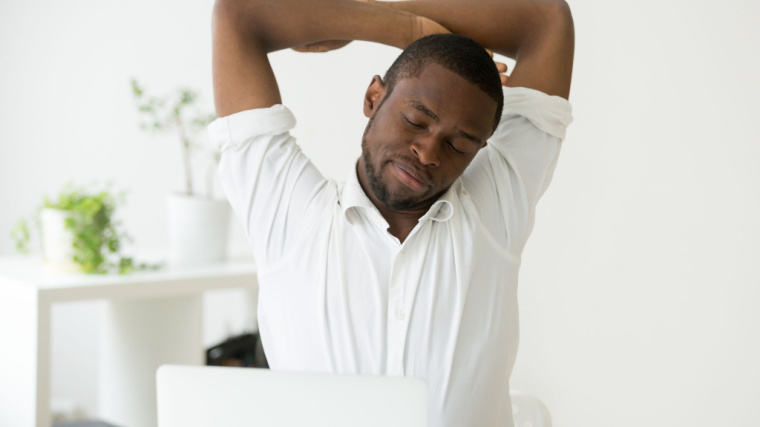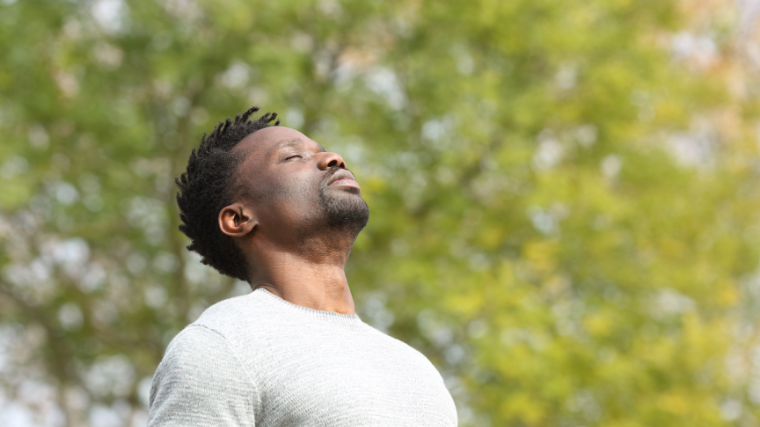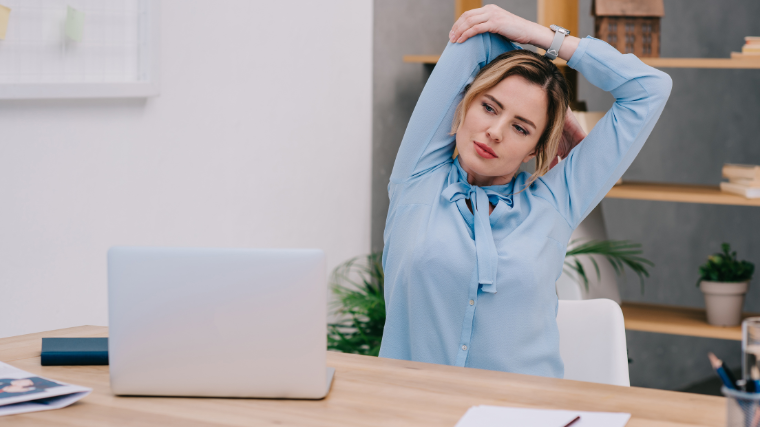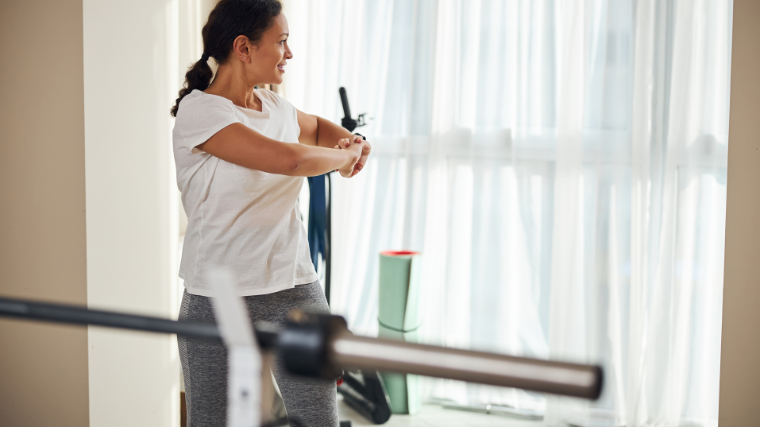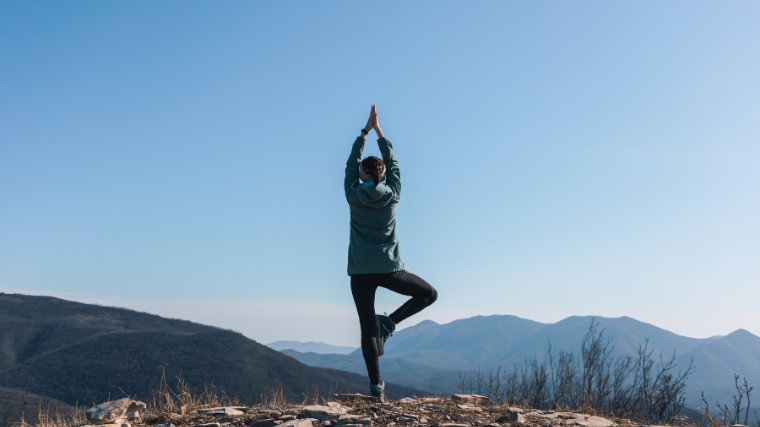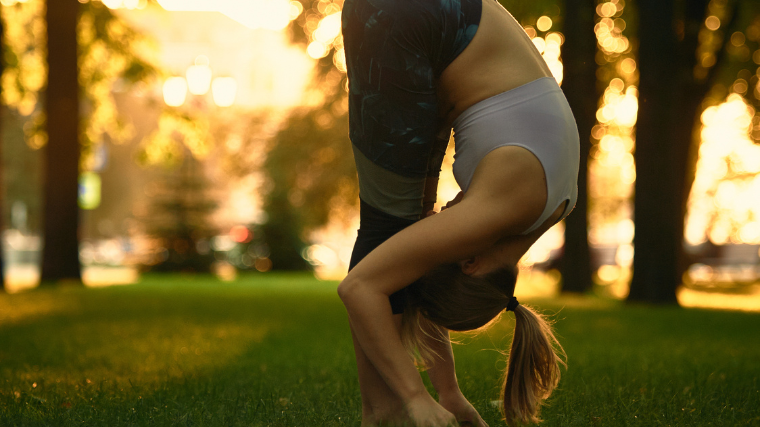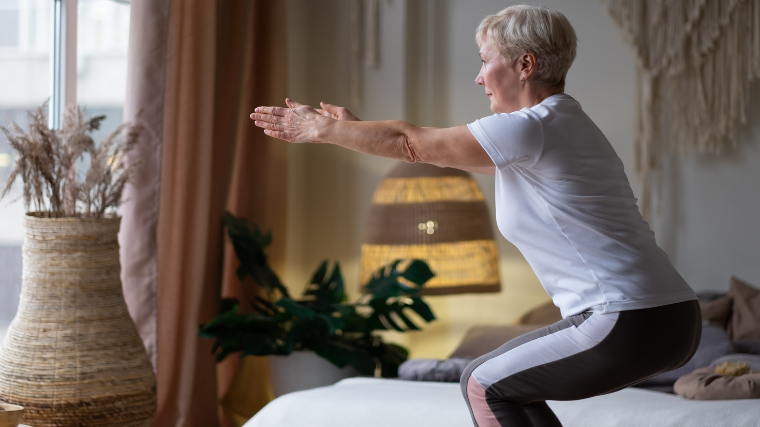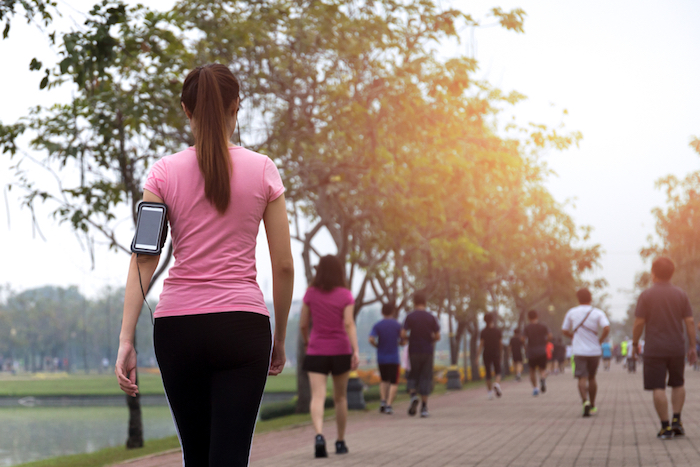Mobility workouts might be less glamorous than slinging around heavy barbells. But just because daily stretching isn’t quite as Instagram-worthy as stunning tandem weightlifting feats, mobility training is the secret sauce behind every successful, well-executed lift.
It can be tough to integrate mobility workouts into your day-to-day routine, especially if you don’t tend to like stretching. But by peppering these at-work stretches throughout your day at the office, you’ll stand to improve your mobility and your lifts. You’ll also be breaking up the physical monotony of the day, finding ways to move more often, and decreasing overall stress levels.
All of these factors constitute the often overlooked keys to the strength training kingdom. Here are some of the best stretches to do at work for more success at the gym.
At-Work Stretches
- Breathing Exercise
- Shoulder Opener
- Torso Twist
- Mountain Flow
- Ragdoll Forward Fold
- Chair Pose
- Walking
Editor’s Note: The content on BarBend is meant to be informative in nature, but it should not be taken as medical advice. When starting a new training regimen and/or diet, it is always a good idea to consult with a trusted medical professional. We are not a medical resource. The opinions and articles on this site are not intended for use as diagnosis, prevention, and/or treatment of health problems. They are not substitutes for consulting a qualified medical professional.
Movements to Increase Your Daily Activity
Let’s explore some simple ways to incorporate movement into your daily routine. You can modify these movements to align with the needs of your body. These moves will help strength athletes with sedentary jobs keep active throughout long days of sitting.
Simple daily exercises can also help strength athletes with very physically active jobs to maintain joint mobility and integrate soothing movements that can help aid recovery. Remember to listen to the true feelings of your body, avoid movements that don’t feel good, and consult a medical professional before starting a new training plan.
Breathing Exercise
Dedicating time and attention to your breath can help you build the foundation for undertaking more vigorous activity. By simply paying attention to the quality and frequency of your breath, you can create the conditions to become more aware of your own body as a whole.
The respiratory system brings oxygen to the cells in your muscles, which allows them to contract and create tension for movement in your body. As few as six long, steady breaths can have a regulating effect on your nervous system. (1)
By simply paying attention to the quality and frequency of your breath, you can ease your recovery by calming your nervous system. To brace effectively under heavy loads, you also need to learn to consciously control your breath. Practicing some form of breath control daily can help you stay calm, keep your muscles tight, and keep your mind in control on the platform.
How to Do it
- Breathe deeply in through your nose. Count slowly in your head to keep track of how many seconds you can comfortably breathe in for. If you can easily get to a count of eight, keep that pace consistent. If you can easily get to a count of three, keep that pace consistent.
- Exhale slowly through your mouth. Try to count to the same number you count to with your inhales.
- Start with five or 10 breaths at a pace that’s comfortable. Gradually increase the length of your inhales and exhales as desired.
You might opt to spend a full minute or two focusing on your breath every hour or every couple of hours. Consider also connecting your breathing activity to specific tasks you know you’ll do every day. Perhaps spend a minute on breathing exercises before you dive into your work email, and another time before you close your laptop for the day.
Shoulder Opener
Releasing tension in your shoulders isn’t just a good way to relax. Your shoulders have a direct relationship with the effectiveness of your lifting routines. With good shoulder mobility, you can start to unlock more achievements in the gym — think overhead squats and snatches. You’ll also open your chest muscles that may be crunched over all day if you’ve got a job that requires a lot of screen time.
Performing shoulder openers a few times throughout each day is also a good way to help clear brain fog, negative thoughts, and anxiety. (2) You don’t even have to stand up to do these. Perform them from a seated position if you want or need to. (3)
How to Do it
- Sit or stand tall with your chest lifted and your shoulders comfortably relaxed. Keep them down and away from your ears.
- Bend your elbows and interlace your fingers behind your head.
- Look up to the sky to lift your chest and bring your elbows out wide. Take a deep breath in while you’re here.
- Then, look down towards your belly, tuck your chin to your chest, and close your elbows in front of your face. Fully exhale here in this position.
- Repeat these steps to the rhythm of your breath as many times as you need to.
- Whenever you are ready, you can bring your arms down, relax your shoulders and your chest, and breathe naturally.
Try doing these every hour on the hour. If your schedule is a bit unpredictable, consider some of these shoulder openers after those long Zoom calls or during your lunch break.
Torso Twist
The more you rotate your torso with intention, the more resilient you can become against accidental rotation. You’ll strengthen your obliques, back, and abs all at once, leading to a stronger ability to resist side-to-side bending during big lifts.
If you’re hunched over your phone or computer all day, torso twists help you straighten up and get some lateral and transverse motion in. You can scale this movement to any pace that feels comfortable.
How to Do it
- Stand with your feet hip-width apart. Face your toes forward and bend your knees gently.
- Bend your elbows and bring your forearms to about a 90-degree angle.
- Rotate your shoulders and torso side-to-side while keeping your hips stable. Depending on your desired level of intensity, you can keep your feet planted or pivot your feet and turn your head and neck for a full-body twist.
- Incorporate your breath into this movement by inhaling and exhaling as you bring your arms from side to side.
- Move with intention and deliberation instead of whipping quickly from side-to-side. Be sure to slow down gently and stop before you feel dizzy.
Perform torso twists for 30 to 60 seconds once every hour or two — or, every time you take a break from intense movement or stand up from intense sitting.
Mountain Flow
Mountain pose, or tadasana in Sanskrit, is a basic yoga asana — or yoga physical posture. It comes under the classification of Hatha yoga and benefits your ankles, knees, hips, spine, and shoulders.
[Read More: The Best Upper Body Exercises and Workouts]
You’ll perform several different movements all wrapped into one “flow.” It’s almost like a barbell complex, except you’ll take out the barbell and the heavy breathing. This simple flow — a series of postures done together in a sequence — is a great way to take a few minutes to move any time.
This move can help you prepare yourself for a big lift on the platform, too. It helps you ground yourself and get ready for any obstacles to come. Practicing this outside of the gym can make it easier to tap into that calm confidence inside the gym.
How to Do it
- Stand tall with your feet hip-width apart and your toes facing forward.
- Let your arms rest at your sides. Take a few deep breaths here.
- When you’re ready, lift your arms above your head. Face your palms towards one another and reach your fingertips to the sky. Spend time breathing here and notice where you can both relax your body and lengthen your limbs. This could be in your arms, your shoulders, your chest, your belly, your hips, your legs, or your feet.
- Keep your palms parallel and gently extend both of your arms to either side, moving from left to right, then front and back at your own pace.
- You can do this for as long as you want while you follow the rhythm of your breath. At any time, you can bring your arms back down and breathe naturally.
Take time out for mountain pose when you’re feeling stressed or overwhelmed. Consider taking a minute or two to move through this pose before a work meeting or before getting in your car for the drive home.
Ragdoll Forward Fold
Ragdoll forward fold, or uttanasana, is another yoga asana from the Hatha yoga tradition. It’s a great way to release lower back tension, improve posture, and increase hip flexibility.
[Read More: Best Lower Back Exercises for Strength and Reduced Pain]
Your hips often get locked up when you spend so much time sitting — or even standing. This forward fold can help you open up your hips to take tension and potential pain away from your lower back. It can also get you primed for your next session in the squat rack by keeping your hips mobile enough to squat deep.
How to Do it
- Stand tall with your feet hip-width apart.
- Bend your knees generously and reach your fingers down to the floor. Your fingers or palms may come to rest on the ground, or there may be some space between your fingers and the ground.
- Either way, keep your knees bent, shift your weight towards your heels, and relax your belly and chest towards or on your thighs.
- Let the top of your head get heavy and relax, so you lengthen the muscles in the back of your neck and shoulders.
- Breathe naturally, letting the air come in slowly and gently, and let it out effortlessly.
- If you want to add some movement to this position, you can lightly rock from your heels to your toes, or swing from side to side, at any pace that is comfortable for you.
If your hips and lower body generally start to feel stiff during the day, drop into this position. You also might want to set an alarm for every half hour or so to remind yourself to move in this way.
Chair Pose
Chair pose, or utkatasana, is a strengthening asana that engages your full body. This pose is similar to a basic squat, a dynamic movement that strengthens the lower body.
You can perform a bodyweight squat by lengthening your legs to stand tall, then bending your knees and shifting your weight to your heels to bring your hips down to chair pose. Be sure to place some distance between your feet for this variation so your hips have more room to do the movement.
How to Do it
- To do chair pose, first decide where you would like your feet to be. You can place them with some distance between your inner arches if your hips require more space. Alternatively, you can place your feet with your big toes touching together.
- Once you are in a comfortable position, bend your knees to lower your hips any amount — it can be a little bit or a lot. Breathe while you are here.
- You can place your arms where they feel secure. It could be reaching up above your head or reaching out with your arms out into a T-shape. You could keep your hands together at the center of your chest, on your hips, or at your sides. Stay here and keep breathing.
- Squeeze your glutes to stabilize your hips and squeeze your inner thighs to secure your feet. Press your toes down to lower your hips more if you want.
If you’re looking to improve your thoracic mobility, try venturing into reaching your arms over your head during this position. This one will often take a bit more leg strength, so use it when you want to give your lower body a little action without necessarily working up a sweat.
Walking
Okay, so this one isn’t technically a stretch. But it is called “stretching your legs,” so we’re going to take it.
Walking has many well-known health benefits, such as the reduced risk of heart disease, improved immune function, and lower blood pressure. (4)(5) Whether you take a long walk or several short trips throughout the day, remember to mix it up by changing your pace, using elements of your environment such as incline to challenge you. Incorporate other activities and people you enjoy into your walk — bring your dog along or meet a friend at the coffee shop.
If you’re a strength athlete, walks are especially important. They help get your muscles moving and your blood pumping to help aid your muscle recovery process. Going for long and/or vigorous walks also helps improve your cardiovascular endurance, which can come in handy when you’re trying to increase your work capacity in the gym.
How to Do It
- Stand tall with your shoulders back and down, away from your ears.
- Take a step forward with one foot, then the next.
- Keep your arms comfortable and relaxed at your sides.
- You can move as slowly or as quickly as you’d like.
Customize your daily walks to your current ability level. If you’re coming back from injury or experience chronic pain, a few minutes of slow walking at a time may be all your body needs for the moment. Gradually increase your time and then, when you’re able, increase the pace.
How to Integrate Stretching at Work
If you’ve got five minutes to spare, you have enough time to integrate an effective, complete five-minute mobility routine. But if you hate stretching or just don’t know how to put those five minutes aside during your work day, rest assured. You can integrate at-work stretches into your day on your own terms.
Set a timer on your phone to go off every hour. When it rings, take a quick scan of your body. Ask yourself what parts of your body feel tight or like they could just use a bit of movement. It could be that your neck is tense because you’ve been hunched forward over your phone. Or you might find that your legs are cramping under your desk and you need to get out and take a stroll.
Once you identify which part of your body needs to be stretched, turn to these at-work stretches to help. Opening up through your shoulders and taking deep breaths can help when you’re stressed from that last meeting and your upper body needs a break. Opt for torso twists or chair poses when your whole body needs a recharge.
Hold static stretches between 30 seconds and one minute per side. Perform dynamic stretches (like torso twists) for the same amount of time, making sure to keep reps even on both sides. If you’re taking a walk, try to get at least a five to 10-minute stroll in. Remember to breathe during every kind of stretch.
Work Your Stretches
Putting in the work on the lifting platform is essential to sliding more weight plates onto the bar. But if you want to be as effective as possible in getting strong, you’ll have to put in some work outside of the gym, too.
Focusing on your mobility training is a spectacular way to improve your big barbell lifts while also breaking up the sedentary stillness of the workday. Instead of remaining still all day at work, use these at-work stretches to get more mobile and stronger all at once.
References
- Jerath R, Edry JW, Barnes VA, Jerath V. Physiology of long pranayamic breathing: neural respiratory elements may provide a mechanism that explains how slow deep breathing shifts the autonomic nervous system. Med Hypotheses. 2006;67(3):566-71.
- Saeed SA, Cunningham K, Bloch RM. Depression and Anxiety Disorders: Benefits of Exercise, Yoga, and Meditation. Am Fam Physician. 2019 May 15;99(10):620-627.
- Manini TM, Carr LJ, King AC, Marshall S, Robinson TN, Rejeski WJ. Interventions to reduce sedentary behavior. Med Sci Sports Exerc. 2015 Jun;47(6):1306-10.
- Nieman DC, Wentz LM. The compelling link between physical activity and the body’s defense system. J Sport Health Sci. 2019 May;8(3):201-217.
- Soroush A, Der Ananian C, Ainsworth BE, Belyea M, Poortvliet E, Swan PD, Walker J, Yngve A. Effects of a 6-Month Walking Study on Blood Pressure and Cardiorespiratory Fitness in U.S. and Swedish Adults: ASUKI Step Study. Asian J Sports Med. 2013 Jun;4(2):114-24.
Featured Image: fizkes / Shutterstock
